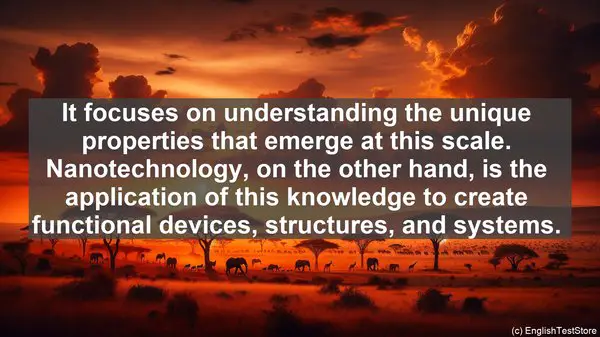Introduction to the Video
Welcome to today’s lesson. Nanotechnology is a fascinating field, but it can also be quite complex. One of the challenges in studying nanotechnology is the presence of numerous terms that sound similar but have distinct meanings. In this lesson, we will explore the top 10 commonly confused words in nanotechnology. By understanding the differences between these terms, you will be able to navigate the field with more confidence. So, let’s get started!

1. Nanoscale vs. Microscale
The first pair of words that often cause confusion is ‘nanoscale’ and ‘microscale.’ Both terms refer to size, but they represent different scales. Nanoscale refers to dimensions in the range of 1 to 100 nanometers, while microscale is larger, ranging from 1 to 100 micrometers. To put it in perspective, a nanometer is a billionth of a meter, while a micrometer is a millionth of a meter. Understanding this distinction is crucial, as properties at the nanoscale can differ significantly from those at the microscale.
2. Nanoparticles vs. Nanomaterials
Another pair of words that are often used interchangeably but have distinct meanings are ‘nanoparticles’ and ‘nanomaterials.’ Nanoparticles refer to particles with dimensions in the nanoscale. On the other hand, nanomaterials encompass a broader category, including not just particles but also nanoscale structures, films, and coatings. So, while all nanoparticles are nanomaterials, the reverse is not true. Nanomaterials have a wide range of applications, from electronics to medicine.

3. Nanoscience vs. Nanotechnology
The terms ‘nanoscience’ and ‘nanotechnology’ are often used interchangeably, but they have different scopes. Nanoscience is the study of phenomena and manipulation of materials at the nanoscale. It focuses on understanding the unique properties that emerge at this scale. Nanotechnology, on the other hand, is the application of this knowledge to create functional devices, structures, and systems. In simple terms, nanoscience is about understanding, while nanotechnology is about application.
4. Bottom-Up vs. Top-Down Approaches
When it comes to fabricating nanoscale structures, two common approaches are ‘bottom-up’ and ‘top-down.’ Bottom-up approaches involve building structures by assembling individual atoms or molecules. It’s like constructing a building by placing one brick at a time. Top-down approaches, on the other hand, start with a larger structure and then carve out the desired nanoscale features. It’s like sculpting a statue from a block of stone. Both approaches have their advantages and are used depending on the specific requirements.
5. Quantum Dots vs. Carbon Nanotubes
Two nanomaterials that often cause confusion are ‘quantum dots’ and ‘carbon nanotubes.’ Quantum dots are tiny semiconductor particles that exhibit unique optical and electronic properties due to quantum confinement. They find applications in areas like display technology and solar cells. Carbon nanotubes, on the other hand, are cylindrical structures made of carbon atoms. They have exceptional mechanical strength and electrical conductivity, making them useful in fields like electronics and materials science.
6. Nanorobotics vs. Nanomanipulation
In the realm of nanoscale manipulation, two terms that are sometimes used interchangeably are ‘nanorobotics’ and ‘nanomanipulation.’ Nanorobotics refers to the design and operation of robots at the nanoscale. These robots can perform tasks like drug delivery or precision assembly. Nanomanipulation, on the other hand, is the more general term for manipulating objects at the nanoscale, regardless of whether it involves robots or not. It can include techniques like using atomic force microscopy to move individual atoms.
7. Nanotoxicology vs. Nanosafety
As nanotechnology advances, ensuring its safety becomes crucial. Two related terms in this context are ‘nanotoxicology’ and ‘nanosafety.’ Nanotoxicology focuses specifically on studying the potential toxic effects of nanomaterials on living organisms. It involves assessing factors like the material’s size, shape, and surface properties that can influence its toxicity. Nanosafety, on the other hand, is a broader term that encompasses not just toxicity but also other safety aspects, such as exposure control and risk management.
8. Nanofabrication vs. Nanomanufacturing
While ‘nanofabrication’ and ‘nanomanufacturing’ may sound similar, they represent different stages in the production process. Nanofabrication refers to the techniques used to create nanoscale structures, often in a research or prototyping setting. It involves processes like lithography and deposition. Nanomanufacturing, on the other hand, is the scaled-up production of nanoscale products. It focuses on efficiency, cost-effectiveness, and quality control, similar to traditional manufacturing processes.
9. Self-Assembly vs. Self-Organization
Two terms that often come up in the context of nanoscale materials are ‘self-assembly’ and ‘self-organization.’ Self-assembly refers to the spontaneous arrangement of individual components into an ordered structure without external intervention. It’s like the pieces of a puzzle coming together on their own. Self-organization, on the other hand, involves the emergence of ordered patterns or behaviors in a system due to the interactions between its components. Both processes are essential in creating complex nanoscale structures.
10. Nanosensors vs. Biosensors
The final pair of words we’ll explore is ‘nanosensors’ and ‘biosensors.’ Nanosensors are devices that can detect and measure phenomena at the nanoscale. They can be used to monitor things like temperature, pressure, or the presence of specific molecules. Biosensors, on the other hand, are a specific type of sensor that utilize biological components, such as enzymes or antibodies, to detect a target analyte. They find applications in areas like medical diagnostics and environmental monitoring.
